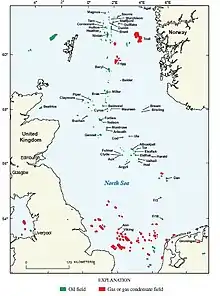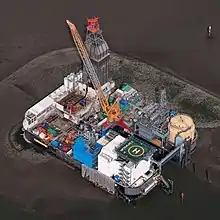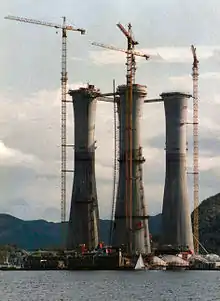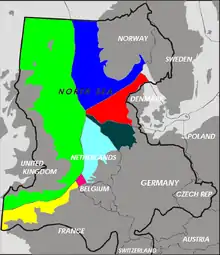North Sea oil
North Sea oil is a mixture of hydrocarbons, comprising liquid petroleum and natural gas, produced from petroleum reservoirs beneath the North Sea.


In the petroleum industry, the term "North Sea" often includes areas such as the Norwegian Sea and the area known as "West of Shetland", "the Atlantic Frontier" or "the Atlantic Margin" that is not geographically part of the North Sea.
Brent crude is still used today as a standard benchmark for pricing oil, although the contract now refers to a blend of oils from fields in the northern North Sea. On 9 March 2020, the Brent Crude price fell to $34.36, below the UK production cost of $39.20.[1][2] Norway and Denmark have production costs of less than $13 per barrel.
History
1851–1963
Commercial extraction of oil on the shores of the North Sea dates back to 1851, when James Young retorted oil from torbanite (boghead coal, or oil shale) mined in the Midland Valley of Scotland.[3] Across the sea in Germany, oil was found in the Wietze field near Hanover in 1859, leading to the discovery of seventy more fields, mostly in Lower Cretaceous and Jurassic reservoirs, producing a combined total of around 1340 m³ (8,400 barrels) per day.[3]
Gas was found by chance in a water well near Hamburg in 1910, leading to minor gas discoveries in Zechstein dolomites elsewhere in Germany.[3] In England, BP discovered gas in similar reservoirs in the Eskdale anticline in 1938, and in 1939 they found commercial oil in Carboniferous rocks at Eakring in Nottinghamshire.[3] Discoveries elsewhere in the East Midlands lifted production to 400 m³ (2,500 barrels) per day, and a second wave of exploration from 1953 to 1961 found the Gainsborough field and ten smaller fields.[3]
The Netherlands' first oil shows were seen in a drilling demonstration at De Mient during the 1938 World Petroleum Congress at The Hague.[3] Subsequent exploration led to the 1943 discovery by Exploratie Nederland, part of the Royal Dutch/Shell company Bataafsche Petroleum Maatschappij, of oil under the Dutch village of Schoonebeek, near the German border.[4] NAM found the Netherlands' first gas in Zechstein carbonates at Coevorden in 1948.[4] 1952 saw the first exploration well in the province of Groningen, Haren-1, which was the first to penetrate the Lower Permian Rotliegendes sandstone that is the main reservoir for the gas fields of the southern North Sea, although in Haren-1 it contained only water.[5] The Ten Boer well failed to reach target depth for technical reasons, but was completed as a minor gas producer from the Zechstein carbonates.[5] The Slochteren-1 well found gas in the Rotliegendes in 1959,[5] although the full extent of what became known as the Groningen gas field was not appreciated until 1963—it is currently estimated at ≈96×1012 cu ft (2,700 km3) recoverable gas reserves.[4] Smaller discoveries to the west of Groningen followed.
1964–present
The UK Continental Shelf Act came into force in May 1964. Seismic exploration and the first well followed later that year. It and a second well on the Mid North Sea High were dry, as the Rotliegendes was absent, but BP's Sea Gem rig struck gas in the West Sole Field in September 1965.[6] The celebrations were short-lived since the Sea Gem sank, with the loss of 13 lives, after part of the rig collapsed as it was moved away from the discovery well.[6] The Viking Gas Field was discovered in December 1965 with the Conoco/National Coal Board well 49/17-1, finding the gas-bearing Permian Rotliegend Sandstone at a depth of 2,756 m subsea.[7] Helicopters were first used to transport workers.[8] Larger gas finds followed in 1966—Leman Bank, Indefatigable and Hewett, but by 1968 companies had lost interest in further exploration of the British sector, a result of a ban on gas exports and low prices offered by the only buyer, British Gas.[6] West Sole came onstream in May 1967.[6] Licensing regulations for Dutch waters were not finalised until 1967.
The situation was transformed in December 1969, when Phillips Petroleum discovered oil in Chalk of Danian age at Ekofisk, in Norwegian waters in the central North Sea.[6] The same month, Amoco discovered the Montrose Field about 217 km (135 mi) east of Aberdeen.[6] BP had been awarded several licences in the area in the second licensing round late in 1965, but had been reluctant to work on them.[6] The discovery of Ekofisk prompted them to drill what turned out to be a dry hole in May 1970, followed by the discovery of the giant Forties Oil Field in October 1970.[6] The following year, Shell Expro discovered the giant Brent oilfield in the northern North Sea east of Shetland in Scotland and the Petronord Group discovered the Frigg gas field. The Piper oilfield was discovered in 1973 and the Statfjord Field and the Ninian Field[9] in 1974, with the Ninian reservoir consisting of Middle Jurassic sandstones at a depth of 3000 m subsea in a "westward tilted horst block".
Off shore production, like that of the North Sea, became more economical after the 1973 oil crisis caused the world oil price to quadruple, followed by the 1979 oil crisis, causing another tripling in the oil price. Oil production started from the Argyll & Duncan Oilfields (now the Ardmore) in June 1975[10] followed by Forties Oil Field in November of that year.[11] The inner Moray Firth Beatrice Field, a Jurassic sandstone/shale reservoir 1829 m deep in a "fault-bounded anticlinal trap", was discovered in 1976 with well 11/30-1, drilled by the Mesa Petroleum Group (named after T. Boone Pickens' wife Bea, "the only oil field in the North Sea named for a woman")[12] in 49 m of water.[13]

Volatile weather conditions in Europe's North Sea have made drilling particularly hazardous, claiming many lives (see Oil platform). The conditions also make extraction a costly process; by the 1980s, costs for developing new methods and technologies to make the process both efficient and safe, far exceeded NASA's budget to land a man on the moon.[14] The exploration of the North Sea has been a story of continually pushing the edges of the technology of exploitation (in terms of what can be produced) and later the technologies of discovery and evaluation (2-D seismic, followed by 3-D and 4-D seismic; sub-salt seismic; immersive display and analysis suites and supercomputing to handle the flood of computation required).
The Gullfaks oil field was discovered in 1978.[15] The Snorre Field was discovered in 1979, producing from the Triassic Lunde Formation and the Triassic-Jurassic Statfjord Formation, both fluvial sandstones in a mudstone matrix.[16] The Oseberg oil field[17] and Troll gas field were also discovered in 1979.[18] The Miller oilfield was discovered in 1983.[19] The Alba Field produces from sandstones in the middle Eocene Alba Formation at 1860 m subsea and was discovered in 1984 in UKCS Block 16/26.[20] The Smørbukk Field was discovered in 1984 in 250–300 m of water that produces from Lower to Middle Jurassic sandstone formations within a fault block.[21] The Snøhvit Gas Field[22] and the Draugen oil field were discovered in 1984.[23] The Heidrun oil field was discovered in 1985.[24]
The largest UK field discovered in the past twenty-five years is Buzzard, also located off Scotland, found in June 2001 with producible reserves of almost 64×106 m³ (400m bbl) and an average output of 28,600 m3 to 30,200 m3 (180,000–220,000 bbl) per day.[25]
The largest field found in the past five years on the Norwegian part of the North Sea, is the Johan Sverdrup oil field which was discovered in 2010, with further oil of the same field was discovered the next year. Total reserves of the field are estimated at 1.7 to 3.3 billion barrels of gross recoverable oil and Johan Sverdrup is expected to produce 120,000 to 200,000 barrels of oil per day. Production start is planned to happen in 2018. It is one of the largest discoveries made in the Norwegian Continental Shelf.[26]
As of January 2015, the North Sea was the world's most active offshore drilling region with 173 active rigs drilling.[8] By May 2016, the North Sea oil and gas industry was financially stressed by the reduced oil prices, and called for government support.[27]
The distances, number of workplaces and fierce weather push the 750,000 square kilometre (290,000 square mile) North Sea area to operate the world's largest fleet of heavy instrument flight rules (IFR) helicopters, some specifically developed for the North Sea. They carry about two million passengers per year from sixteen onshore bases, of which Aberdeen Airport is the world's busiest with 500,000 passengers per year.[8]
Licensing

Following the 1958 Convention on the Continental Shelf and after some disputes on the rights to natural resource exploitation[28] the national limits of the exclusive economic zones were ratified. Five countries are involved in oil production in the North Sea. All operate a tax and royalty licensing regime. The respective sectors are divided by median lines agreed in the late 1960s:
- United Kingdom – Exploration and production licences are regulated by the Oil and Gas Authority following the 2014 Wood Review on maximising UKCS oil and gas recovery. Licences were formerly granted by the Department of Energy and Climate Change (DECC – formerly the Department of Trade and Industry). The UKCS (United Kingdom Continental Shelf) is divided into quadrants of 1 degree latitude and one degree longitude. Each quadrant is divided into 30 blocks measuring 10 minutes of latitude and 12 minutes of longitude. Some blocks are divided further into part blocks where some areas are relinquished by previous licensees. For example, block 13/24a is located in quad 13 and is the 24th block and is the 'a' part block. The UK government has traditionally issued licences via periodic (now annual) licensing rounds. Blocks are awarded on the basis of the work programme bid by the participants. The UK government has actively solicited new entrants to the UKCS via "promote" licensing rounds with less demanding terms and the fallow acreage initiative, where non-active licences have to be relinquished.
- Norway – Oljedirektoratet (the Norwegian Petroleum Directorate (Website in English) grants licences. The NCS is also divided into quads of 1 degree by 1 degree. Norwegian licence blocks are larger than British blocks, being 15 minutes of latitude by 20 minutes of longitude (12 blocks in a quad). Like in Britain, there are numerous part blocks formed by re-licensing relinquished areas.
- Denmark – Energistyrelsen (the Danish Energy Agency (website in English) administers the Danish sector. The Danes also divide their sector of the North Sea into 1 degree by 1 degree quadrants. Their blocks, however, are 10 minutes latitude by 15 minutes longitude. Part blocks exist where partial relinquishment has taken place.
- Germany – Germany and the Netherlands share a quadrant and block grid—quadrants are given letters rather than numbers. The blocks are 10 minutes latitude by 20 minutes longitude. Germany has the smallest sector in the North Sea.
- Netherlands – The Dutch sector is located in the Southern Gas Basin and shares a grid pattern with Germany.
Reserves and production
The British and Norwegian sectors hold most of the large oil reserves. It is estimated that the Norwegian sector alone contains 54% of the sea's oil reserves and 45% of its gas reserves.[29] More than half of the North Sea oil reserves have been extracted, according to official sources in both Norway and the UK. For Norway, Oljedirektoratet[30] gives a figure of 4,601 million cubic metres of oil (corresponding to 29 billion barrels) for the Norwegian North Sea alone (excluding smaller reserves in Norwegian Sea and Barents Sea) of which 2,778 million cubic metres (60%) has already been produced prior to January 2007. UK sources give a range of estimates of reserves, but even using the most optimistic "maximum" estimate of ultimate recovery, 76% had been recovered as of the end of 2010. Note the UK figure includes fields which are not in the North Sea (onshore, West of Shetland).
United Kingdom Continental Shelf production was 137 million tonnes of oil and 105 billion m³ of gas in 1999.[31] (1 tonne of crude oil converts to 7.5 barrels).[31][32][33] The Danish explorations of Cenozoic stratigraphy, undertaken in the 1990s, showed petroleum-rich reserves in the northern Danish sector, especially the Central Graben area.[34] The Dutch area of the North Sea followed through with onshore and offshore gas exploration, and well creation.[35][36]
Exact figures are debatable, because methods of estimating reserves vary and it is often difficult to forecast future discoveries.
When it peaked in 1999, production of North Sea oil was nearly 950,000 m³ (6 million barrels) per day. Natural gas production was nearly 280×109 m³ (10 trillion cubic feet) in 2001; it continues to increase, although British gas production is in sharp decline.
UK oil production has seen two peaks, in the mid-1980s and the late 1990s,[8] with a decline to around 300×103 m³ (1.9 million barrels) per day in the early 1990s. Monthly oil production peaked at 13.5×106 m³ (84.9 million barrels) in January 1985[37] although the highest annual production was seen in 1999, with offshore oil production in that year of 407×106 m³ (398 million barrels) and had declined to 231×106 m³ (220 million barrels) in 2007.[38] This was the largest decrease of any oil-exporting nation in the world, and has led to Britain becoming a net importer of crude for the first time in decades, as recognized by the energy policy of the United Kingdom. The production is expected to fall to one-third of its peak by 2020. Norwegian crude oil production as of 2013 is 1.4 mbpd. This is a more than 50% decline since the peak in 2001 of 3.2 mbpd.
Geology
The geological disposition of the UK's oil and gas fields is outlined in the following table.[39][40]
| Geological Era | Geological Epoch | Age, million years | Fields |
|---|---|---|---|
| Tertiary | Pliocene | 2–5 | |
| Miocene | 5–23 | ||
| Oligocene | 23–34 | ||
| Eocene | 34–56 | Frigg, Gannet, Alba | |
| Palaeocene | 56–66 | Arbroath, Balmoral, Everest, Forties, Heimdal, Maureen, Montrose, Nelson | |
| Mesozoic | Cretaceous | 66–145 | Lower: Britannia, Scapa |
| Jurassic | 145–201 | Upper: Moray Firth fields, Brae, Buzzard, Claymore, Fulmar, Magnus, Piper, Scott, Tiffany
Kittiwake, Gannet Middle: Brent, Bruce, Eider, Heather, Hutton, Ninian, Tern Lower to Middle: Beatrice | |
| Triassic | 201–252 | Upper: Beryl
Dotty, Douglas, Esmond, Hamilton, J-Block, Morecambe Bay Lower: Hewett | |
| Palaeozoic | Permian | 252–299 | Upper Permian (Zechstein): Argyll, Auk
Lower Permian (Rotliegend): Camelot, Indefatigable, Leman, Viking, West Sole |
| Carboniferous | 299–359 | Caister, Murdoch | |
| Devonian | 359–419 | Buchan | |
| Silurian | 419–444 | ||
| Ordovician | 444–485 | ||
| Cambrian | 485–541 |
Carbon dioxide sequestration
In the North Sea, Norway's Equinor natural-gas platform Sleipner strips carbon dioxide out of the natural gas with amine solvents and disposes of this carbon dioxide by geological sequestration ("carbon sequestration") while keeping up gas production pressure. Sleipner reduces emissions of carbon dioxide by approximately one million tonnes a year; that is about 1⁄9000th of total emissions.[41] The cost of geological sequestration is minor relative to the overall running costs. As of April 2005, BP is considering a trial of large-scale sequestration of carbon dioxide stripped from power plant emissions in the Miller oilfield as its reserves are depleted.
See also
- Carbon sink
- Category of Oil fields in Norway
- Commercial offshore diving in the North Sea
- Economy of Norway
- Economy of Scotland
- Economy of the United Kingdom
- Energy use and conservation in the United Kingdom
- Geography of the United Kingdom
- Geology of the United Kingdom
- It's Scotland's oil
- List of oil and gas fields of the North Sea
- List of oil fields
- Oil and gas industry in the United Kingdom
- Oil platform
- Subsea
- United Kingdom Climate Change Programme
References
- "Brent Crude Oil Price Charts". OilPrice.com.
- "Cost of Producing a Barrel of Crude Oil by Country - knoema.com". Knoema.
- Glennie, KW (1998). Petroleum Geology of the North Sea: Basic Concepts and Recent Advances. Blackwell Publishing. pp. 11–12. ISBN 978-0-632-03845-9.
- "About NAM". NAM.
- Stauble, AJ; Milius, G (1970). "Geology of Groningen Gas Field, Netherlands". M 14: Geology of Giant Petroleum Fields. AAPG A009. pp. 359–369.
- Ferrier, RW; Bamberg, JH (1982). The History of the British Petroleum Company. Cambridge University Press. pp. 201–3. ISBN 978-0-521-78515-0.
- Gage, M., 1980, "A Review of the Viking Gas Field," in Giant Oil and Gas Fields of the Decade: 1968–1978, AAPG Memoir 30, Halbouty, M.T. editor, Tulsa: American Association of Petroleum Geologists, ISBN 0891813063, p., 39
- Swartz, Kenneth I. (16 April 2015). "Setting the Standard". Vertical Magazine. Archived from the original on 18 April 2015. Retrieved 18 April 2015.
- Albright, W.A., Turner, W.L., and Williamson, K.R., "Ninian Field, U.K. sector, North Sea," in Giant Oil and Gas Fields of the Decade: 1968–1978, AAPG Memoir 30, Halbouty, M.T. editor, Tulsa: American Association of Petroleum Geologists, ISBN 0891813063, p. 173
- "Key Dates in UK Offshore Oil & Gas Production". UK Offshore Operators Association. Archived from the original on 2009-02-09.
- "1975: North Sea oil begins to flow". BBC. 1975-11-03. Retrieved 2010-05-20.
- Pickens, T. Boone, 2000, The Luckiest Guy in the World, Washington: Beard Books, ISBN 1587980193, pp. 112–122.
- Linsley, P.N., Potter, H.C., McNab, G., and Racher, D., 1980, "The Beatrice Field, Inner Moray Firth, U.K., North Sea," in Giant Oil and Gas Fields of the Decade: 1968–1978, AAPG Memoir 30, Halbouty, M.T. editor, Tulsa: American Association of Petroleum Geologists, ISBN 0891813063, p., 117
- "High costs, high stakes on the North Sea". Time. 1975-09-29. Retrieved 2010-05-20.
- Petterson, O., Storli, A., Ljosland, E., Nygaard, O., Massie, I., and Carlsen, H., 1992 "The Gullfaks Field," in Giant Oil and Gas Fields of the Decade, 1978–1988, AAPG Memoir 54, Halbouty, M.T., editor, Tulsa: American Association of Petroleum Geologists, ISBN 0891813330, pp. 429–446
- Jorde, K., and Diesen, G.W., "The Snorre Field, 1992," in Giant Oil and Gas Fields of the Decade, 1978–1988, AAPG Memoir 54, Halbouty, M.T., editor, Tulsa: American Association of Petroleum Geologists, ISBN 0891813330, pp. 407–416
- Hagen, J., and Kvalheim, B., "Oseberg Field, 1992," in Giant Oil and Gas Fields of the Decade, 1978–1988, AAPG Memoir 54, Halbouty, M.T., editor, Tulsa: American Association of Petroleum Geologists, ISBN 0891813330, pp. 417–428
- Bolle, L., 1992, "Troll Field," in Giant Oil and Gas Fields of the Decade, 1978–1988, AAPG Memoir 54, Halbouty, M.T., editor, Tulsa: American Association of Petroleum Geologists, ISBN 0891813330, pp. 447–458
- McClure, N.M., and Brown, A.A., 1992, "Miller Field," in Giant Oil and Gas Fields of the Decade, 1978–1988, AAPG Memoir 54, Halbouty, M.T., editor, Tulsa: American Association of Petroleum Geologists, ISBN 0891813330, pp. 307–322
- Mattingly, G.A., Bretthauer, H.H., 1992, "The Alba Field," in Giant Oil and Gas Fields of the Decade, 1978–1988, AAPG Memoir 54, Halbouty, M.T., editor, Tulsa: American Association of Petroleum Geologists, ISBN 0891813330, pp. 297–305
- Ehrenberg, S.N., Gjerstad, H.M., and Hadler-Jacobsen, F., 1992, "Smorbukk Field," in Giant Oil and Gas Fields of the Decade, 1978–1988, AAPG Memoir 54, Halbouty, M.T., editor, Tulsa: American Association of Petroleum Geologists, ISBN 0891813330, pp. 323–348
- Linjordet, A., Grung Olsen, R., 1992, "The Jurassic Snohvit Gas Field, Hammerfest Basin, Offshore Northern Norway," in Giant Oil and Gas Fields of the Decade, 1978–1988, AAPG Memoir 54, Halbouty, M.T., editor, Tulsa: American Association of Petroleum Geologists, ISBN 0891813330, pp. 349–370
- Provan, D.M., 1992, "Draugen Oil Field, Haltenbanken Province, Offshore Norway," in Giant Oil and Gas Fields of the Decade, 1978–1988, AAPG Memoir 54, Halbouty, M.T., editor, Tulsa: American Association of Petroleum Geologists, ISBN 0891813330, pp. 371–382
- Whitley, P.K., 1992, "The Geology of Heidrun," in Giant Oil and Gas Fields of the Decade, 1978–1988, AAPG Memoir 54, Halbouty, M.T., editor, Tulsa: American Association of Petroleum Geologists, ISBN 0891813330, pp. 383–406
- "Oil & Gas Jobs and News. Rigzone Empowers Professionals in Oil and Gas". www.rigzone.com.
- "Johan Sverdrup Field, North Sea". Offshore Technology. Retrieved 2016-09-20.
- Mark Lammey. "North Sea industry heading for Lehman Brothers magnitude crash". 27 May 2016.
- Johnston, Douglas M. (1976). Marine Policy and the Coastal Community: The Impact of the Law of the Sea (illustrated ed.). Taylor & Francis. p. 197. ISBN 978-0-85664-158-9.
- Jan Hagland, Director of Information for the Norwegian Petroleum Directorate. "Oil & Gas in the North Sea – ExploreNorth". Retrieved 2007-07-24.
- Norwegian "Facts 2007" official report, available freely here, Archived 2009-03-27 at the Wayback Machine, page 82
- Trewin, N. H. (2002). "Hydrocarbons". The Geology of Scotland: Edited by N.H. Trewin. Geological Society of London. p. 463. ISBN 978-1-86239-126-0.
- "Oil & Gas UK - Education - Key Dates". The United Kingdom Offshore Oil and Gas Industry Association trading as Oil & Gas UK. 2008. Archived from the original on 2009-02-09. Retrieved 2008-11-29."Oil and gas production peaked at a record 125 million tonnes of oil and 105 billion cubic metres of gas."
- Morton, Glenn R. "An Analysis of the UK North Sea Production". Archived from the original on 2007-12-18. Retrieved 2007-12-09.
- Konradi, P. (February 2005). "Cenozoic stratigraphy in the Danish North Sea Basin" (PDF). Geological Survey of Denmark and Greenland. Netherlands Journal of Geosciences — Geologie en Mijnbouw. 84 (2): 109–111. Retrieved 2008-11-19.
- "Gas exploration in Dutch sector North Sea – Ascent Resources plc". Archived from the original on 2008-06-16. Retrieved 2008-11-19.
- "Hanze F2A, Dutch North Sea, Netherlands". offshore-technology.com is a product of SPG Media Limited. SPG Media Limited, a subsidiary of SPG Media Group PLC. 2008. Retrieved 2008-11-19.
- "UK Oil Production(m³)". BERR. Archived from the original on 2009-07-03. Retrieved 2008-09-26. (multiply figures by 0.98 to convert cubic metres to barrels)
- "UK National Accounts 2011 edition (The Blue Book), section 13.1" (PDF). BERR. (multiply figures by 6.841 to convert tonnes of oil to barrels)
- Institute of Petroleum (1978). A guide to North Sea oil and gas technology. London: Heyden & Son. pp. 3–20. ISBN 0855013168.
- Geological Society of London. "Lyell collection - Petroleum Geoscience". Retrieved 29 September 2020.
- "Global Carbon Emissions". Retrieved 2016-09-20.
Further reading
- Kemp, Alex. The Official History of North Sea Oil and Gas. Volume I: The Growing Dominance of the State; Volume 2: Moderating the State’s Role (2011) excerpt and text search
- Kemp, Alexander G., C. Paul Hallwood, and Peter Woods Wood. "The benefits of North Sea oil." Energy Policy 11.2 (1983): 119–130.
- Noreng, Oystein. The oil industry and government strategy in the North Sea (1980)
- Page, S. A. B. "The Value and Distribution of the Benefits of North Sea Oil and Gas, 1970—1985." National Institute Economic Review 82.1 (1977): 41–58.
- Toye, Richard. "The New Commanding Height: Labour Party Policy on North Sea Oil and Gas, 1964–74." Contemporary British History 16.1 (2002): 89–118.
External links
- Energy Voice
- Norway 2015 North Sea oil at the (US) Energy Information Administration
- UK Department for Business, Enterprise & Regulatory Reform
- Danish North Sea oil and gas production, Danish Energy Authority
- OLF Norwegian Operators association
- Oil & Gas UK
- Petroleum Exploration Society of Great Britain
- The OilCity Project, stories and anecdotes from people involved in the North Sea Oil & Gas industry.
- Interactive Map over the Norwegian Continental Shelf, live information, facts, pictures and videos.
- Oil and the City Aberdeen's relationship with the oil industry.
- map of oil and gas infrastructure in the Danish sector
- map of oil and gas infrastructure in the British Sector

